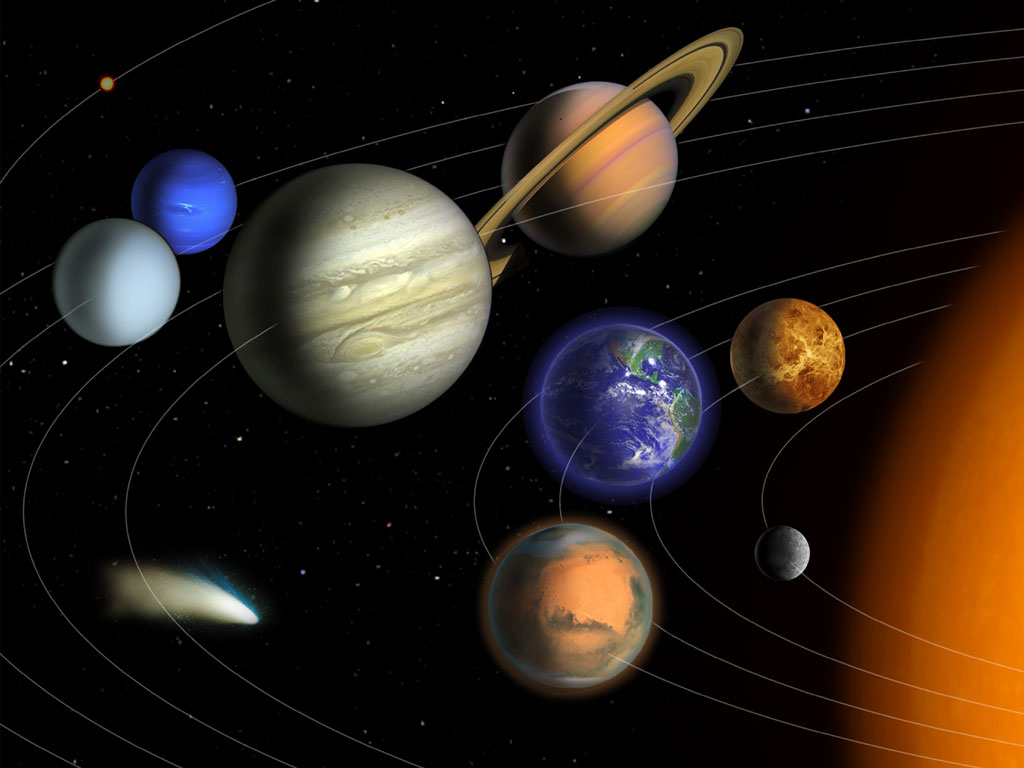
Planets Of Our Solar System
The planets of our solar system are as varied as is life on on our planet. We know that because Astronomers are constantly learning about our solar system. There is still so much to learn and it will be fun to try and keep up. This is an introduction to the planets of our solar system and if you have a burning desire to learn about space and everything inside it then keep reading and we can begin our journey.
Planets of our Solar System
There are several celestial bodies here that we call planets. Since Pluto is no longer considered a planet I will not be including it in this article. However, I just want to say it pains me not to do so as my entire childhood it was considered a planet.
Mercury
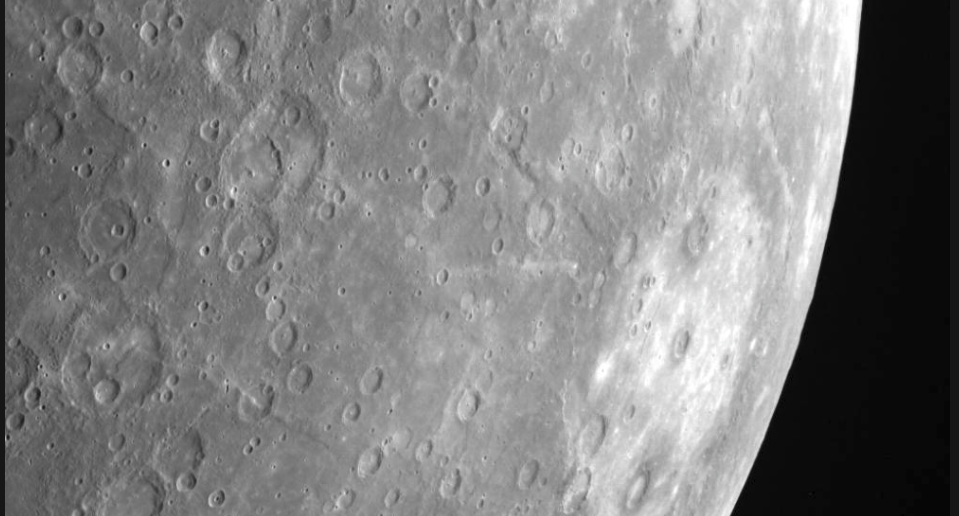
Mercury is the closest planet to the Sun. It is hard to see because it always stays close to it. Because of this, it is only visible just before dawn or right after sunset. So it is only visible for an hour or two each day.
- When closest to Earth, Mercury is about .50 AU from us
- Its radius is around 2450 km
- Average density is 5400 \(\frac{kg}{m^3}\)
- The surface gravity is around 0.4 that of Earth
There is something interesting here I wanted to mention. The Earth's average density is around 5500 \(\frac{kg}{m^3}\). It is a lot larger than Mercury. We can therefore surmise that Mercury must have a lot of high density rocks inside it.
Atmosphere of Mercury
Since Mercury is so small there is very little atmosphere. The reason for this has to do with its mass. A planet with a large mass will always have more atmosphere. This is because molecules need to have a higher escape velocity to get away from the planet and there will just be fewer that do if the planet has a high mass.
With no atmosphere Mercury has fluctuating temperatures. They can range from 100k to 700k. To clarify that, temperatures go to below freezing to way over boiling. Try that for a day!
Surface of Mercury
It is hard for us to see the surface of Mercury. What we do know is that it is heavily cratered and a hot barren wasteland. It is much too hot for liquid water to stay there. There is evidence of lava flows which fill up some of the craters. The craters all come from meteors that bombard the surface. It's surface has cliffs on them called a Scarp. No one is sure of what caused them but they happened after the meteoric bombardment. There are no plate tectonics or other geologic activity either.
Rotation of Mercury
The Sun directly affects the rotation rate of Mercury. This is due to the massive gravity of the Sun. By using some sophisticated radar we found out that its rotation is only 59 days. Most people expected it to match its orbital rate since the Sun has it locked.
Interior of Mercury
Mercury has a small magnetic field. It does not do much and is barely measurable but it is there. There are not the usual high amounts of heavy metals to form a magnetic field. Instead, the field is generated by the molten core on the inside. It most likely has a solid inner core and a molten outer core.
Venus
Venus is similar in many ways to Earth. It's size, density, and orbital distance from the Sun are extremely close. The similarities end there. Venus ended up very hot unlike us. Astronomers have many questions about it and why it ended up the way it did. Since Venus is the second planet from the Sun it was bound to be hot. It's orbit intertwines with Earth's orbit. Venus has a nickname, its called "the morning star". The reason this came about is because you can usually only see it in the morning before the full sunrise.
Venus is the brightest planet in the sky. It is so bright because it is very reflective.
- Closest distance to Earth = \(.28 AU\)
- Radius = \(6000 km\)
- Density = \(5200 \frac{kg}{m^3}\)
Rotation of Venus
The rotation of this planet is very interesting. It is opposite of the other planets. Venus is also tilted majorly so its day and night cycle is really messed up. One Venus day is around 225 Earth days and this is because of how tilted it is. It rotates very slowly.
No one knows why Venus rotates so slowly and backwards. Some have guess that it got hit by something very large and thus caused it to stop rotating normally. All this does make it similar to our moon in that we always see the same side of Venus or close to it.
Venus
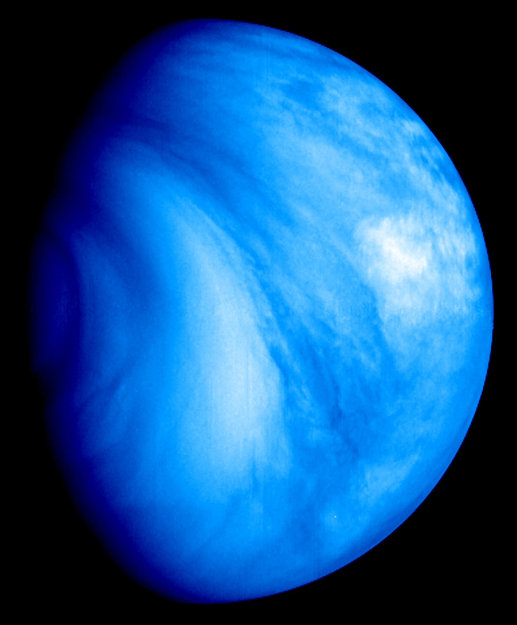
We can't see Venus very well from here on Earth. Even though its size and density are the closest to Earth's, it behaves much differently. The cloud cover is too thick to make out much detail for example. To see the details of the atmosphere you have to look at its ultraviolet radiation. When seen like this it looks much better.
It turns out that it is also quite hot on Venus. That is as expected since it is still very close to the Sun. Astronomers do constantly watch this interesting planet. More is being learned at a steady rate.
Conditions on the Surface
Large radar telescopes have given us a decent picture of the surface. Space probes launched long ago have added to our knowledge too. Continents have even been found which is just wonderful. There may not be plate tectonics like there is on Earth, however.
There are volcanoes and flowing lava on the surface to make things interesting. The lava has shaped the surface and so makes it a significant influence.
Volcanism Within Venus
Venus has a lot of features due to volcanoes. While volcanism is usually doe to plate tectonics it is not the case on Venus. We do not really know why the volcanoes formed where they did. The volcanism that is there formed when lava got too concentrated in one area. After too much lava was in one area it bubbled up to the surface. The lava usually does not stay on the surface though. Often it recedes back underground. When it does this the surface above is devastated the lava forms a large and smooth crater.
A crater formed like that is called is called a corona. It is a big and circular region of the surface. Sulfur dioxide in the atmosphere indicates that there are still likely active volcanoes on Venus.
The Air Above Venus
The atmosphere of Venus is very different that Earth's atmosphere. It is hot and filled with carbon dioxoide. This makes it unbreathable of course. First of all, there is a lot more atmosphere around Venus than there is Earth. The atmospheric pressure is also much greater which is due to its mass. All of these attributes make it a harsh environment. There is also a high speed wind in the upper atmosphere that blows \(300-400 \frac{km}{h}\).
The atmosphere of Venus is mostly carbon dioxide. It makes up around 96% on the air there. The rest is mostly nitrogen so not helpful to make it easier to breathe. There is virtually no oxygen there at all.
The clouds are very reflective strangely enough. It is not something we are used to seeing here on Earth. We do not know exactly why the atmosphere on Venus is reflective. Astronomers are still working on that as we get more data on it.
Venus does have a major greenhouse effect on it. The reason is all the carbon dioxide on it. That is a good reason to watch its levels on our own planet. Since there is so much of a greenhouse effect there it makes it much hotter than it should be.
The main reason that the greenhouse effect took over was because of the proximity to the Sun. It was just slightly too close to the Sun. The heat made the temperature too hot for the gases and they escaped into the upper atmosphere. Earth seems perfectly placed in many ways.
Magnetic Field of Venus
It has been measured multiple time but there appears to be no magnetic field. It should have some sort of magnetic field though because its makeup is very similar to Earth's. This fact is most likely because of its slow rotation. Rotation is a major factor in the forming of a magnetic field. Unfortunately this also means there is no protection against the solar winds which are rough on anything.
Mars
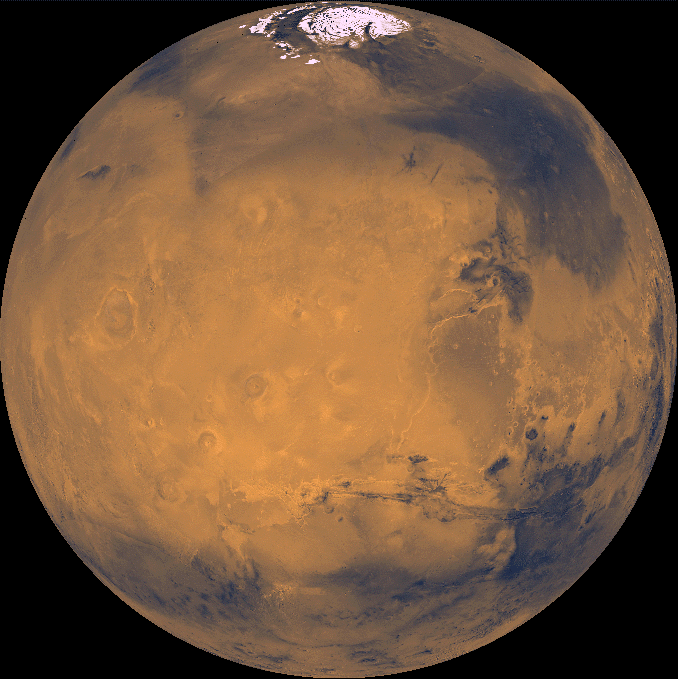
It gets its name from the ancient Romans. The planet has been a constant target for science fiction writers. It's the most interesting planet in......Well, you see where I was going with that. Mars has always been a hot topic. No pun intended. It is very similar to Earth; even more so than Venus. That is the reason we have studied it more than any other planet. We have the Mars rover there now constantly learning about it.
It's Orbit
Mars is the 4th planet from the Sun and the last of the terrestrial planets. All the others in our solar system are mostly gaseous planets. Its orbit is similar to ours in that it appears to go in a big elongated circle. The path it takes is very eccentric. This makes its perihelion distance quite different than its aphelion. The perihelion distance is when Mars is closest to the Sun. Its aphelion distance is when it is at its farthest distance from the Sun. Since they are so different Mars gets many different levels of sunlight throughout the year.
Physical Properties
- Radius = 3400 km
- Mass = \( 6.4 * 10^23 kg \)
- Density = \(3900 \frac{kg}{m^3}\)
- Rotation = once every 24 hours
The core of Mars is supposed to be iron sulfide. This material is made when both iron and sulfur are heated up so they can join together.
The polar caps on Mars are not made of water but instead they are made of carbon dioxide. They melt a lot when it is warm but reform when the temperature drops a lot.
Mars has moons and yes that is a plural statement. They are Phobos and Deimos. There is not much to them as they are just big rocks. Phobos is the larger of the two.
Surface of Mars
The surface varies quite a bit. There are canyons, volcanoes, and plains for instance. One thing that everyone notices when they see pictures of Mars is the difference between the north and south. The north is made up of plains due to volcanoes and smooth lava surfaces. These volcanic features cover a large territory in the north.
The south is made up of heavily cratered regions. These are the dark areas we see from Earth.
Volcanoes on Mars
The largest volcanoes in our solar system are on Mars. The largest one, called Olympic Mons, has a \(350 km\) radius at its base. This makes it close to the size of Texas. It and the other volcanoes here are formed by a large amount of lava just under their surface. It is basically an upwelling of lava. The height of these volcanoes is due to the surface gravity. It is quite a bit less than here on Earth so the volcanoes can go higher without crumbling due to their mass.
There is a large amount of cratering evidence on Mars. Most of them are large craters though. Mars does not have too thick of an atmosphere for rocks to get through but the high winds erase all of the small impacts.
Water on Mars
We currently can't find much water on Mars. Long ago there probably was water in various places. Regardless, scientists are wanting to find it because that would indicate the possibility of life on Mars. That would be an enormous discovery.
Scientists think there was water there because of runoff channels just like here on Earth.
The Polar Caps
They are mostly carbon dioxide and very large. There is a part that fluctuates in size. This is called the seasonable cap. Then there is the residual cap which stays frozen all year long. Their temperatures can vary quite a bit.
Atmosphere
The atmosphere around Mars is thin and mainly carbon dioxide. It is more similar to Venus in this respect. The rest of the atmosphere appears made up of nitrogen and argon. It contains a troposphere where most of the weather forms. It is a little cooler on Mars than on Earth. Presently scientists think that it is an average of 50 K cooler.
Dust storms are prevalent and very powerful. They are much stronger than anything here on Earth.
The Core of Mars
Astronomers think the crust is around \(100 km\) thick. There appears to be no magnetic field either. Fluctuations do exist but not an overall field around the planet.
Mars rotates rapidly. One would expect or hope for a magnetic field around the planet then. This is not the case though. Since there is no magnetic field we can only assume the core of Mars is not as dense as Earth. It takes a very dense core and rapid rotation to form a planetary magnetic field.
Jupiter

Jupiter is the largest of the planets in our solar system. It and the other jovian planets are all very different than the planets we have talked about so far. They are gaseous and very large.
Properties of Jupiter
It is the 5th planet from the Sun. Since it is also the 3rd brightest object in our sky it is easy to find. There are many moons of Jupiter. This is because of Jupiter's immense size and gravitational attraction. Anything that gets close to it will get captured.
- Mass = \(1.9*(10^27)kg\)
- Radius = \(71,500 km\)
- Density = \(1300 \frac{kg}{m^3}\)
- Rotation = 9 hours
Jupiter is very large. It's mass is over 300 times that of the Earth. It is also much less dense as you can see. Scientists think it is made up of mostly hydrogen and helium. There is also no solid surface on Jupiter. The planet is made entirely of gases. Very strange indeed. Those gases all move at different rates and at different altitudes. This is partial reason we see the banding in pictures.
This rotation is called differential rotation and means that one location will rotate faster than at another location. Its overall rotation rate is the fastest among the planets of our solar system.
Jupiter's Atmosphere
Most people know Jupiter by its largest storm, the Red Spot. It is twice as large as the Earth itself. This weather storm has gone on for hundreds of years. It is characteristic of the weather on Jupiter. The bands that go around Jupiter are clouds that are very pretty if I may say so.
Using spectroscopy we can tell Jupiter's atmosphere is made of mostly hydrogen. The second most abundant gas is helium. Many other gases make up the remaining portion. The atmosphere's makeup is because of the strong gravity of this massive planet. It is so strong it keeps all the gases in and very compressed. Usually, gases would float off into space just like Mercury, Venus, and Mars.
The bands in the atmosphere are the result of convective motion. Lighter bands are mostly higher air currents while the dark colored bands are downward moving currents.
The different colors in the bands are suspected to be chemical reactions among elements. Scientists do not know what elements or reactions that are taking place yet. They are still working on it.
The cloud systems are layered in three main systems.
Weather is complicated and erratic on this huge planet. The best example is the storm called the Red Spot. It has been raging for at least 300 years. Possibly much longer than that. We do not know what fuels this storm or why it is red to our sight.
The best guess is since there is no land on Jupiter, there is nothing to disrupt the storms. So large storms just rage on and on.
The rest of the planet seems covered in smaller storms.
Inside Jupiter
Scientists do not know a lot about the interior of Jupiter. Though it is one of the most observed planets of our solar system its insides are still a mystery. They do not think there is any land or continents. Since it is then mostly gas it must be highly pressurized to stay together the way it does.
Jupiter probably has its own energy source. Scientists think that because internal temperatures are different than what they had guessed. It is said that Jupiter emits a lot more energy into space than it receives from the Sun. Think about that. That means something is producing a lot of energy somewhere on the inside.
Scientists have some guess. For example, one guessed that certain types of energy must be escaping for that to happen. That could be right or it could be something entirely different.
The further you go into the interior the denser and hotter it gets. Gases just become thicker toward the core.
The Magnetic Field
Jupiter has an incredible magnetic field! Scientists say that the radiation sent by Jupiter's field is several thousands times greater than here on Earth. It is much larger also. This means that the energy produced is just profound. for a planet.
The outer part of its magnetosphere constantly struggles with the solar winds produced by the Sun. It is therefore constantly changing its shape and intensity at those outer limits.
Moons of Jupiter
Jupiter has a lot of moons. Depending on your definition of moon, it could be as high as 69. Most are just small rocks. The largest are Io, Europa, Ganymede, and Callisto. These 4 are similar in size to our one moon. Their orbits are pretty regular and spin the same direction for the most part.
The composition of all the smaller moons are basically rocky and appearing to be captured asteroids or comets. An interesting fact is that they seem to model the inner solar system some. An example is that the closest the orbits are the denser the moons. This is very similar to the first 4 planets of our solar system.
Saturn

Saturn may be the most beautiful of the planets in our solar system. Its rings are breathtaking. It is another gaseous planet that is huge and has enormous gravity.
Properties
It is very far from the Sun. This makes it pretty faint and hard to see. For example, several stars are brighter than this planet. It is the 6th planet from the Sun.
- Mass = \(5.7 * 10^26 kg\)
- Radius = \(60,000 km\)
- Density = \(700 \frac{kg}{m^3}\)
- Rotation = 10 hours and 14 min
You can see this is a large planet but not near as big as Jupiter. The density is quite low too. This means that it is made up of hydrogen and helium just like Jupiter. Its rotation is also very fast for a planet its size.
Those Marvelous Rings
The rings are what Saturn is famous for. They are beautiful and easily seen. That is a rare attribute in space. It is also unusual because they are so thin. For a planet the size of Saturn you would expect the rings to be much larger than they are.
Other planets have rings but nothing that compares to the ring system of Saturn. Galileo and Huygens first saw the rings but did not entirely realize what they were. Giovanni Cassini made the first major discovery involving the rings. He identified features that no one previously had.
The ring system is made up of multiple rings. There are 3 main rings, however. They are labeled the A, B, and C rings. The A ring is the outer ring while the A ring is the innermost ring. The B ring is the brightest. There are gaps between the rings too. These are barely visible from Earth.
The rings are made up mostly of water ice. These iceballs orbit Saturn just like a moon would. They vary in size from very small to possibly 20 meters in diameter.
No one knows for sure how the rings came to be. Everyone has guesses of course. Some scientists think they are left over from the forming of Saturn long ago. Others think the rings are destroyed moons or other objects that got too close to the large planet.
I think the latter explanation makes the most sense from what we know presently. The reason why is that the rings are all different ages. To me, that rules out the theory of them being formed near Saturn's formation. Since the rings are all different ages captured moons or or other rocky objects could have strayed too close and got pulverized by Saturn' gravity.
Saturn's Atmosphere
The planet's appearance is plainer when you look it. It is mostly tan colored when you look at it through a telescope. The atmosphere consists mostly of hydrogen, helium, methane, and ammonia. It is interesting to note that that the percentage of helium on Saturn is a lot less than on Jupiter. Scientists are not sure why that is yet.
Saturn rotates rapidly so this dictates is weather a lot. There are many small storms and fast moving winds. The lightning storms in the atmosphere are incredible. They are far stronger than anything seen on Earth.
Interior of Saturn
Saturn's core is not very hot, dense, or pressurized. It is a very cool planet overall. The planet has its own energy source in its core because it radiates a lot more energy than it absorbs. A weird thing that happens is that it has helium rain. This is probably why there is less helium in the atmosphere than Jupiter has.
There is a strong magnetic field in the interior. Saturn;s rapid rotation also helps with this. The magnetic field is oriented opposite that of Earth. On Saturn, north is south. The magnetosphere includes the planet, the rings, and all of the moons.
Moons of Saturn
Saturn has many moons. So far the number is in the 60's. Some even have the potential for life. There are lots of very small ones which are just chunks of ice. Then there are a few medium sized ones that have different traits worth investigating. Finally there is Titan, the one large moon and the one which could harbor life at some point if not already.
Uranus

This planet was discovered in modern times. It was too far away and faint for early astronomers to see and identify it. This planet was discovered by William Herschel in 1781. It is hard to see and does not resolve well even with telescopes compared to other planets.
Orbit
The orbital period of Uranus is large. It is one of the farthest planets from the Sun. The period is around 100 years.
Physical Properties
Uranus is about 4 times larger than the Earth. It is several times more massive. Its density, \(1300 \frac{kg}{m^3}\), is in between the gas planets and Earth. This implies its core is most likely some kind of rocky material.
It rotates quickly. It's rotation is around 17 hours on average.
Uranus has an interesting attribute. It is basically tipped over on it side compared to Earth. It spins sideways too because of this. Scientists do not know why Uranus is tilted this way. It could have been some cataclysmic event or it could have just formed that way.
Atmosphere
The atmosphere of Uranus is very similar to that of Saturn. It consists mostly of hydrogen and helium. There are slight quantities of methane and ammonia too. Jupiter has a lot more ammonia than Uranus and Neptune do. The reason for this is that the colder a planet is the more ammonia freezes.
As a result, the outer planets like Uranus have a lot more methane. Methane makes the outer planets appear blue in color. People often ask this and that is why.
Uranus's Weather
There are clouds and systems on Uranus but nothing like Jupiter or Saturn. Astronomers do not know a lot about the weather systems but it is quite cold there. The lack of temperature may be the reason why there are not so many storms there.
I mentioned it is cold there. Uranus seems to lack any significant heat source like other planets. The clouds are close to the ground where it is warmer. They move really fast too. Wind speeds can be as high as 500 \(\frac{km}{hour}\).
Magnetic Field
The magnetic field and surrounding magnetosphere on Uranus are quite strong. They are much stronger than Earth's magnetic field. However, these magnetic fields are aligned much differently than here on Earth.
Scientists do not know why its magnetic field is aligned the way it is. As usual, most think some cataclysmic event restructured its magnetosphere.
Moons of Uranus
Uranus has several moons. This seems to be characteristic with the larger planets and their immense gravity. They capture anything that gets close. For example, Uranus's moons range from very small rocks to huge moons. There is everything in between as well. Uranus has a couple large moons called Titania and Oberon. These were discovered by Herschel in 1789. Uranus has many other smaller moons that are captured objects.
Ring System of Uranus
All of the outer planets have a ring system. Uranus is no exception. Each planet with rings has its own features and characteristics. The rings were discovered when they passed in front of a star that was being monitored. Its light dimmed and astronomers knew they had found something undiscovered.
The rings of Uranus differ a lot from those of Saturn. They are darker, thinner, and more widely spaced. The rings are evenly spaced.
Neptune
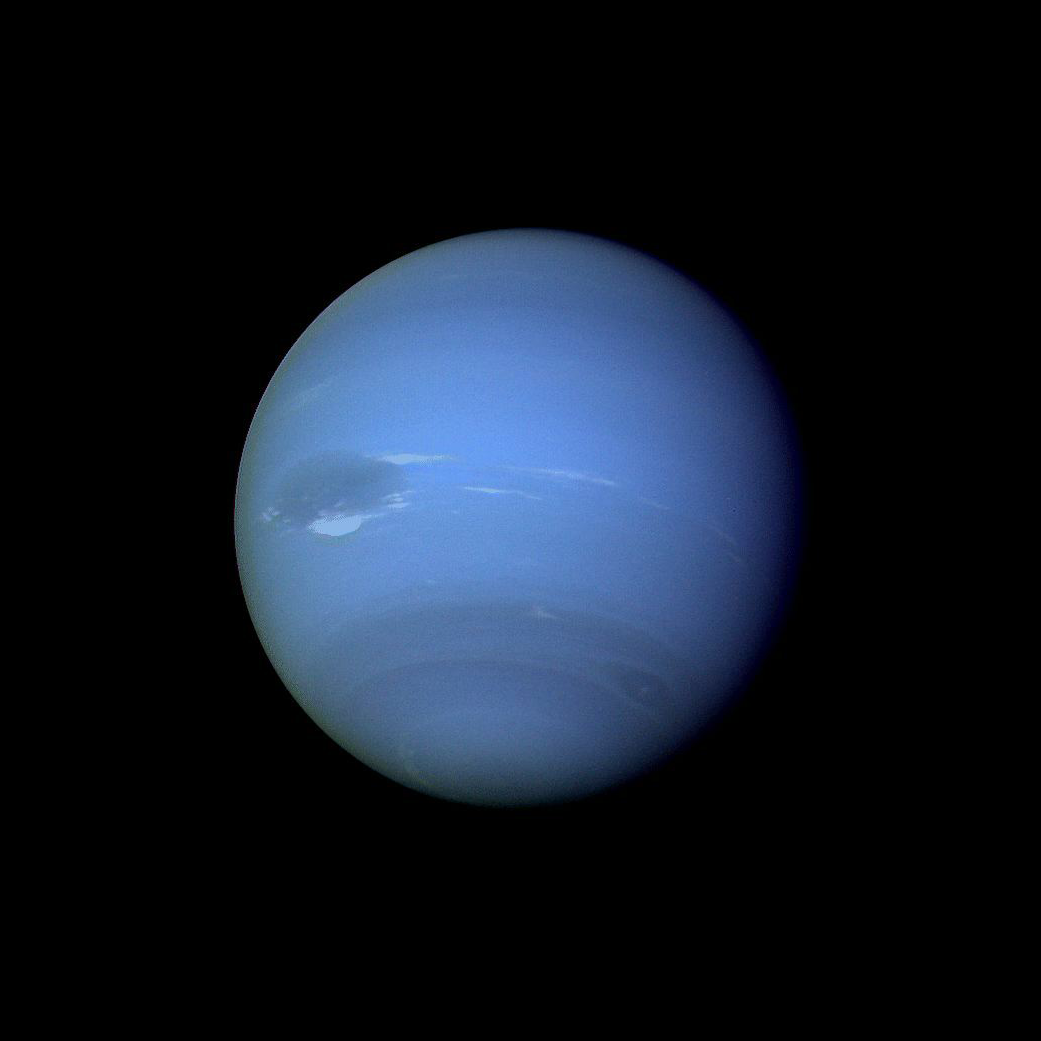
Neptune was discovered in 1846. It was found because scientists studying Uranus noticed that it did not show up in its orbit where it should have been. This happened repeatedly over many years. They guessed that there was something else affecting Uranus by gravity. The scientists turned out to be right and that is how they discovered Neptune.
Neptune's orbital period is around 163 year. That is a long time to orbit so information on Neptune is coming in slow.
Physical Properties of Neptune
Neptune is around 4 times larger than Earth. It is less dense though because if its makeup. The average density of Neptune is around \(1600 \frac{kg}{m^3}\). This density measurement means that the core of Neptune is large and rocky.
The cloud system of Neptune is a lot more varied than Uranus. This atmosphere contains mostly hydrogen and helium. There is more methane in its atmosphere. This makes it the blue color we see in photos.
The reason for this chemical makeup is temperature. Neptune is the coldest of the planets of our solar system. This freezes the ammonia but not the methane. So methane is a lot more abundant than ammonia.
Weather on Neptune
Neptune has more cloud systems and storms than Uranus. It is also warmer because it has an internal energy source. There is a large ongoing storm called the Great Dark Spot. This storm is quite turbulent and has extremely high winds powering it. Winds can blow as high as \(1500 \frac{km}{hour}\).
Magnetic Field of Neptune
Neptune has a strong magnetic field. In fact it is around a hundred times stronger than the field here on Earth. This gives Neptune a significant magnetosphere. Scientists do not know much more about it though because it is so far away.
The Moons of Neptune
Neptune has several moons. Some are decent size too. The two most famous are Triton and Nereid. There are several more which are much smaller. They are all fairly icy however. Triton is about half the size of Earth.
The Rings of Neptune
Neptune also has a few rings around it. They are pretty dark and do not reflect much light. Scientists think they are dark because of radiation that has basically burned them. They are unique because they are very unevenly spaced. Every ring system seems to be different and Neptune's system appears to be no different.
Conclusion
The planets of our solar system are all different and wonderful. Each is unique and teaches us new things. However, there is still much to learn. The amount of knowledge that we do know is very minute. Learning how each of these planets formed and what they are like on the surface will be a many-lifetime endeavor.